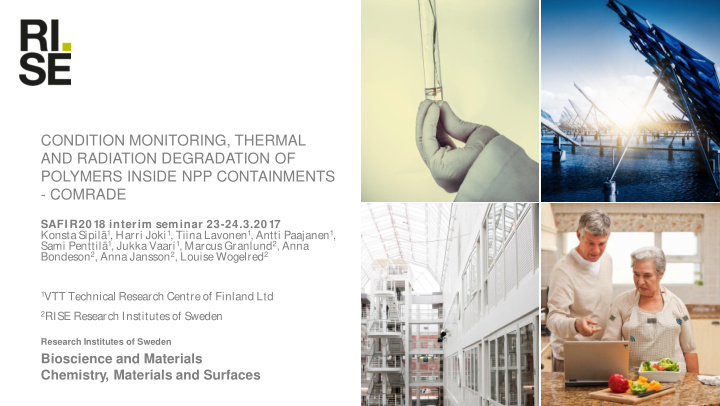



CONDITION MONITORING, THERMAL AND RADIATION DEGRADATION OF POLYMERS INSIDE NPP CONTAINMENTS - COMRADE SAFI R2018 interim seminar 23-24.3.2017 Konsta Sipilä 1 , Harri Joki 1 , Tiina Lavonen 1 , Antti Paajanen 1 , Sami Penttilä 1 , Jukka Vaari 1 , Marcus Granlund 2 , Anna Bondeson 2 , Anna Jansson 2 , Louise Wogelred 2 1 VTT Technical Research Centre of Finland Ltd 2 RISE Research Institutesof Sweden Research Institutes of Sweden Bioscience and Materials Chemistry, Materials and Surfaces
WP1 Development of condition monitoring methods for polymeric components including low dose rate radiation exposure � Ageing of peroxide cured EPDM � O-rings cord diameter 3.53 mm, 25 pcs � Sheets for dumbells 2 mm thick 50 pcs � Ageing in the sequence shown in the time line � 3 different temperatures (90, 120, 140 °C) � Irradiation 29 Gy/h, total dose 14 – 18 kGy � Functional test in test rig shown to the right in both mounted and dismounted state. Leak indicators marked in red � Material properties tested at ecah evaluation � DSC OITe, Hardness, Comp. Set, Tensile, Tightness 2016- Accelerating innovation 2 08-25
WP1 Result � Small difference in material properties between irradiation and Property End of life Initial value non irradiation can be seen. Compression set 105% 4,9% � Furthermore the DSC OITe shows a similar change for both 120 Hardness 80 72,3 °C and 140°C for evaluation 5 even though compression set Elongation at shows a large difference still. 50% 182% break � Correlation of End of life criteria in the table to the right. Tensile strength 7,5 MPa 12,8 MPa DSC – OITe 235,9 ° C 265 ° C 2016- Accelerating innovation 3 08-25
WP2 Barsebäck pre-study and WP3 Polymer ageing mechanisms and effects inside NPP containments - results WP2 results from interviews WP3 goals � The application of computational modelling methods in � Two material experts related to Barsebäck polymer polymer ageing modelling, is it possible to create an components were interviewed in order to clarify whether the ageing model that predicts the macroscale ageing based used components could be taken out from the plant for on the atomic scale reactions? ageing studies � During a DBA, is the thermal or radiation induced ageing � The polymer components available for ageing study which more severe to a polymer and is there some kind of service conditions are well documented are few in numbers synergistic effects? � Radiological clearances and the related precautions to � What kind of techniques could be used in oxidation working with decontaminated materials would yield in gradient studies and how the surface oxidation relates to complicated and costly material acquisition the mechanical properties of polymers? � More feasible way to obtain materials aged in real � How severe is the dose rate effect during normal service conditions would be acquiring materials from running plants life time and what kind of methods exist that could be during annual take outs. used predicting it without resorting to very low dose rate irradiations? 2016- Accelerating innovation 4 08-25
WP3 Polymer ageing mechanisms and effects inside NPP containments � Polymer ageing occurs at different size and time scales. Currently a multi-scale material model that takes account all size and time scales does not exist. The current ageing models are semi-empirical and have limited applicability � 10 2 � From experimental work conducted it was noted that during a DBA, temperature can be either beneficial or Intensity accelerate degradation, depending on the polymer type. The synergistic effects of radiation and heat were 160 experimentally studied with EPDM and CSM. As a result it was noted that increasing temperature can either hinder 120 0.60 or accelerate degradation 80 0.40 � From oxidation profile measurements it was noted that ToF SIMS seems to be a promising method to obtaining from the three techniques tested (FTIR and DSC being others). ToF SIMS was sensitive to detect oxygen content on the 40 0.20 sample surfaces and also sensitive towards surface roughness so careful sample preparation is required 0 0.00 Distance [ � m] � m 0 100 200 300 0 50 100 150 O- Overlay of total (-) ion (red) and O- (green) � For dose rate effect evaluation, three different semi-empirical models (power law model, superposition model and DED model) were identified which could be applied for this purpose. However, they require quite large amount of experimental data in different environments and the use of already existing data is material dependent 2016- Accelerating innovation 5 08-25
THANK YOU! Research Institutes of Sweden RISE Bioscience and Materials Chemistry, Materials and Surfaces
Recommend
More recommend